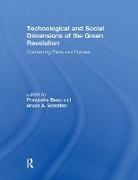Read more
This book draws on case studies from rural communities across the Global South to understand how previous experiences with the Green Revolution can be used to inform new agricultural developments. Its aim is to enable socially just and environmentally sustainable futures for rural communities in a rapidly changing world.
It was published a
List of contents
1. Introduction: Technological and social dimensions of the Green Revolution: connecting pasts and futures 2. Selling Guatemala’s next Green Revolution: agricultural modernization and the politics of GM maize regulation 3. Evaluating the Green Revolution after a decade: a Swaziland case study 4. Malawi’s agricultural input subsidy: study of a Green Revolution-style strategy for food security 5. Challenges for under-utilized crops illustrated by ricebean (Vigna umbellata) in India and Nepal 6. Crop–livestock systems in rural development: linking India’s Green and White Revolutions 7. Growing inequality: agricultural revolutions and the political ecology of rural development
About the author
Pratyusha Basu conducts research on rural-urban intersections, international development and gender issues and she has published one book and numerous peer-reviewed journal articles on global to local aspects of contemporary rural transformations. Her research has been funded by the American Institute of Indian Studies and the U.S. Fulbright program.
Bruce A. Scholten researches the political economy of agriculture and dairy development in India and emerging economies, as well as organic farming in the US and UK. He is the author of two books and numerous peer-reviewed book chapters and journal articles.
Summary
This book draws on case studies from rural communities across the Global South to understand how previous experiences with the Green Revolution can be used to inform new agricultural developments. Its aim is to enable socially just and environmentally sustainable futures for rural communities in a rapidly changing world. It was published a

